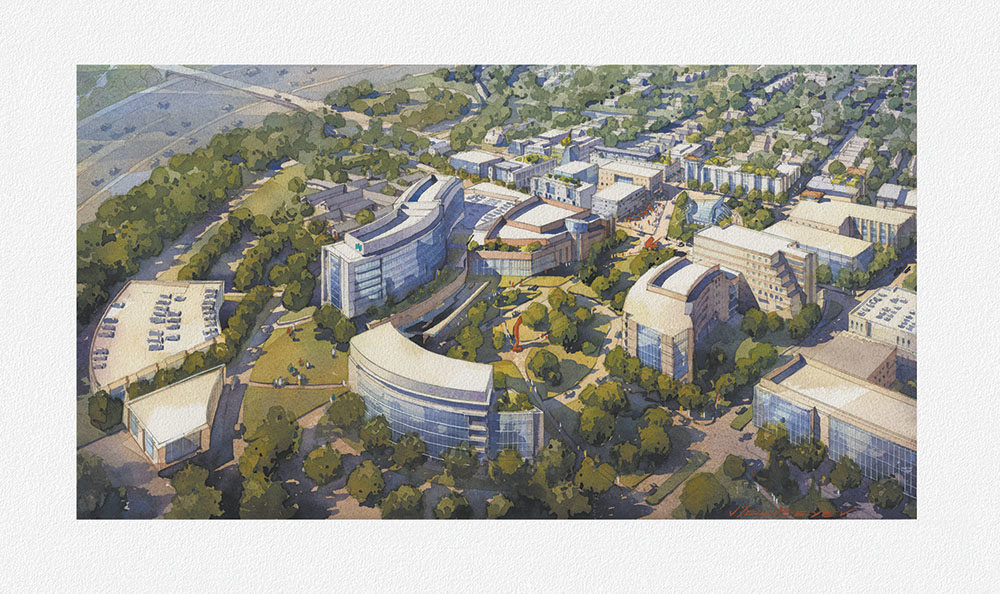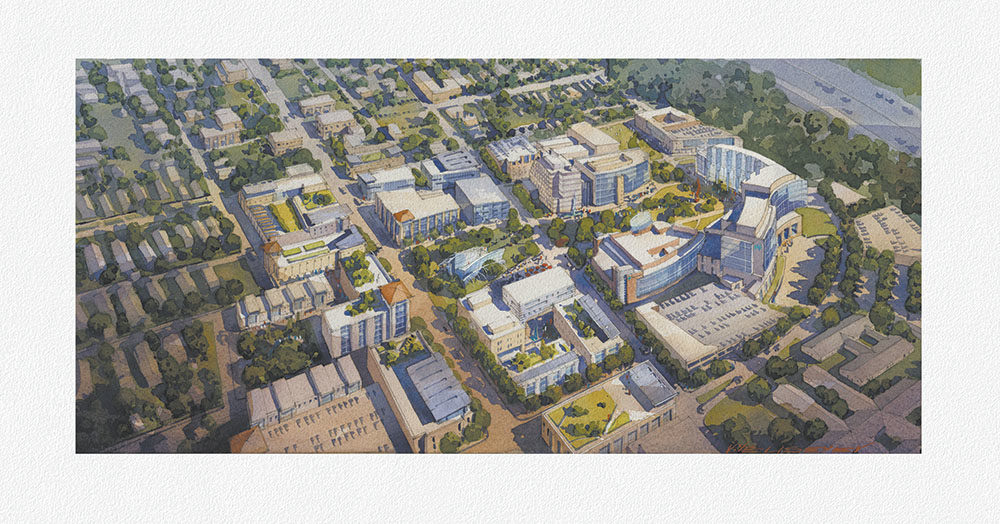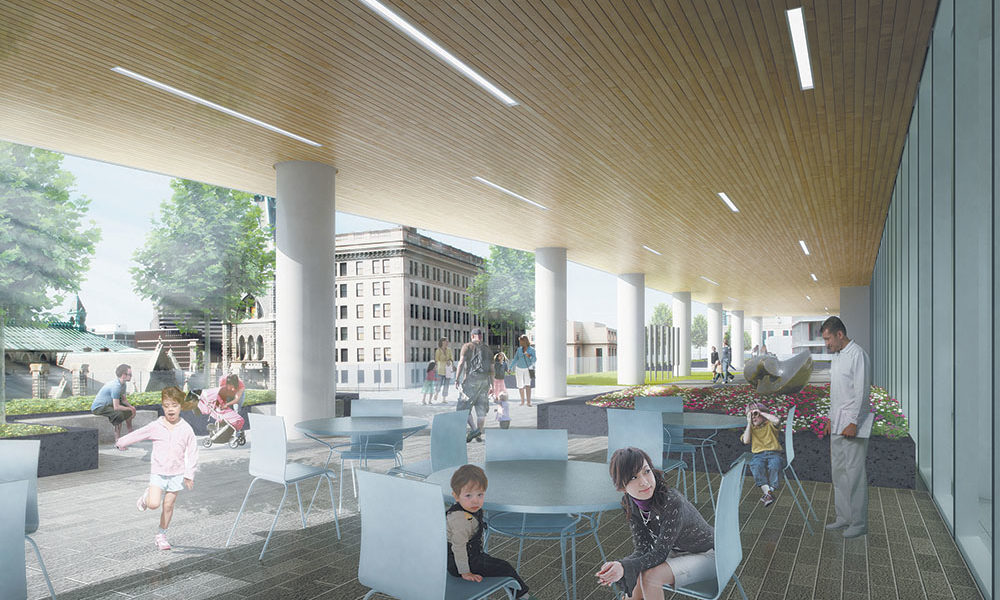Creating Connections: Designing health facilities that enhance the life of a city
By Shannon Kraus & Leslie Hanson
Urban health facilities are as varied and vibrant as the people they serve. From small clinics to large medical centers, these facilities are designed and built for efficiency, comfort, convenience and quality care. They are also carefully interwoven into the fabric of urban life.
As the U.S. healthcare system moves toward accountable care and population health management, providers are looking to serve patients closer to where they live or work. This can mean developing a range of facility types in a major metropolitan area. A Level 1 facility might be a storefront clinic in a strip mall; Level 2, leased space for clinical operations in an existing commercial building; Level 3, leased or newly built space for urgent care and outpatient surgery services; Level 4, a freestanding emergency department or small primary care hospital and Level 5, the main hospital campus, where most of the inpatient beds are located.
Creating flexible spaces
To meet the need for clinical care in a variety of locations throughout its service area, North Carolina-based Duke Medicine worked with HKS Inc., Dallas, to develop a prototype clinic design that can be adapted for use in new or existing buildings. The Duke Primary Care Clinic Prototype is based on a module that includes nine exam rooms and associated work and support space; the design can be scaled from approximately 2,500 square feet up to 100,000 square feet, depending on the clinic space required and the real estate available.
The design de-emphasizes private offices in favor of a central work area that promotes collaborative care. Universal exam rooms give clinics based on this design the flexibility to support a number of different specialties. An onstage/offstage configuration separates staff work areas and circulation routes from patient areas for a more relaxed patient experience. Change-ready facilities based on this type of design provide the connectivity, flexibility and sense of place to serve patients and providers in the urban environment now and into the future.
Logistics and wayfinding are among the primary concerns of larger urban health facilities. Facility design can be instrumental in helping people — especially those from surrounding areas — feel comfortable going to a central, urban location to receive care. The entire arrival sequence is taken into account in the design of these buildings to improve the healthcare experience of people in often-stressful situations. This includes considering the roadways that approach the site and the most helpful placement of signage and billboards. The location of bus or train stops in relation to the hospital entrance is also important in an urban environment. Traffic patterns near the facility may need to be adjusted for the safety and convenience of patients, visitors, staff and others in city neighborhoods.
An inviting presence
In the design of a new pavilion opening soon at the Children’s Hospital of Richmond at Virginia Commonwealth University, the project team created an environment for a future bus stop and recommended the city change the direction of a one-way street in front of the hospital. The entire parking experience at the facility is hospitality-oriented, with space provided for valet service.
The garage itself is positioned beneath the hospital; there are three floors of parking below grade and four floors above grade. A decorative screen allows dappled light to filter into the top four floors of the garage to give the hospital’s parking area a tranquil ambience. The decorative screen serves the dual purpose of shielding the view of the parking garage from the street. An inviting street presence is vital to urban health facilities.
Urban sites generally lend themselves to vertical building designs, with stacked floors rather than large floorplates. This can make wayfinding and circulation especially challenging, particularly in regards to the number and location of elevators. In the CHoR Children’s Pavilion, staff elevators are segregated from public elevators.
A Sky Terrace on the pavilion’s fifth level (immediately above the parking garage) gives people entering the building through the street-level lobby and those coming in from the parking garage a common public space and entry point for elevators leading to the upper diagnostic and treatment floors. The wayfinding scheme is designed to be intuitive. Urban academic medical centers like CHoR see a wide variety of patients, including an indigent population, people from many different cultures and patients with complex medical conditions. Simplifying wayfinding is essential in this type of environment.
Honoring the city
It is also essential for an urban health facility to address the life of its city — to honor its history, respect its present and enhance its future. The Children’s Pavilion is designed so that the Sky Terrace is at the same level as other horizontal elements of buildings along the major thoroughfare where the pavilion is located. The Sky Terrace affords views of Richmond’s historic City Hall and, beyond that, the Virginia state capitol building, designed by Thomas Jefferson. The scale and proportion of the pavilion are purposefully aligned with its urban setting.
“The Children’s Hospital of Richmond Pavilion has been referred to as an oasis for children,” said Robert Reardon, chief facilities officer at VCU Health. “In the center of a very dense urban environment the design of the building and the support operations — such as parking and wayfinding — is truly an oasis where the focus is on the patient, the patient’s family and the elimination of stressors associated with facilities in an urban environment.”
Serving the city
Creating connections within a community is of heightened importance at urban health facilities. This can include anything from fitting the building into complex city infrastructure or transportation plans to providing public amenities, such as dining areas, event space or opportunities for outdoor recreation, in addition to ensuring the building is an asset to the city skyline and streetscape. Beyond providing essential medical services, urban health facilities are often major drivers for investment and employment. This makes master planning a crucial element in creating facilities that will anchor their communities and reflect the culture and beliefs of a health system for many years to come.
MetroHealth, Cleveland, is in the midst of developing a 20-year master plan for its entire medical campus, which is over 175 years old. The development priorities for the next five years are being finalized. Some parts of the plan are already underway, such as the demolition of an unused, outdated psychiatric hospital and the vertical expansion of a critical care pavilion scheduled for completion this summer.
The master plan is intended to transform the campus, MetroHealth’s model of care and the surrounding community, with an emphasis on health and wellness. The planning has involved a great deal of neighborhood input to ensure the project is in sync with the broader ambitions of the city. Urban facility projects involve coordinating with many stakeholders, such as park districts, public works departments, public-private partnerships, mass transit authorities, neighborhood associations, business groups and multiple levels of government.
In these projects, the evolving healthcare environment meets dynamic metropolitan life. Urban facilities present an opportunity to have a tremendous impact on large populations of people who depend on everything from neighborhood clinics to acute care hospitals to maintain their health and that of their city.
Author: Shannon Kraus & Leslie Hanson
Shannon Kraus, FAIA, FACHA, LEED AP, a principal at HKS, Inc., has 20 years of experience in healthcare planning for projects around the globe. Leslie Hanson, AIA, principal, HKS Inc., has more than 34 years of experience in a career dedicated to healthcare architecture.
Posted May 10, 2016
More Articles:
- Coverings 2024
Apr 22, 2024 – Apr 25, 2024 - Hospital, Outpatient Facilities & Medical Office Buildings Summit
Apr 25, 2024 – Apr 25, 2024 - CxA Workshop & Exam
Apr 29, 2024 – Apr 30, 2024 - EMP Seminar & Exam at CxEnergy 2024
Apr 29, 2024 – Apr 30, 2024 - CxEnergy
Apr 29, 2024 – May 2, 2024 - PHCC West 2024
Apr 29, 2024 – May 2, 2024 - Lean in Design Forum 2024
May 1, 2024 – May 2, 2024














